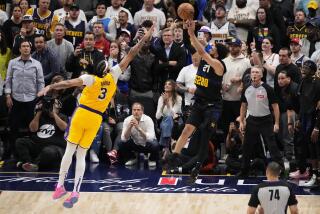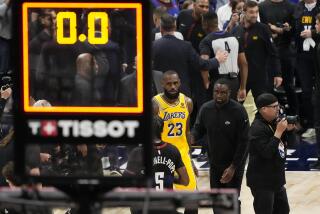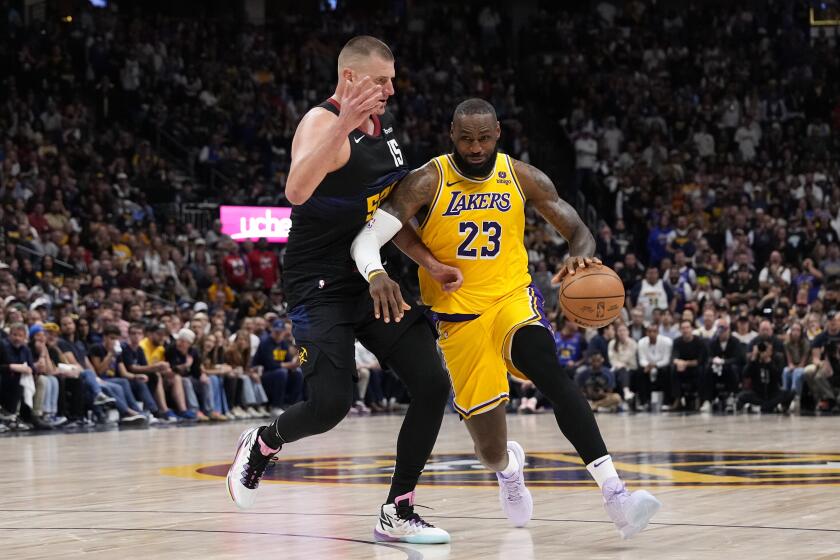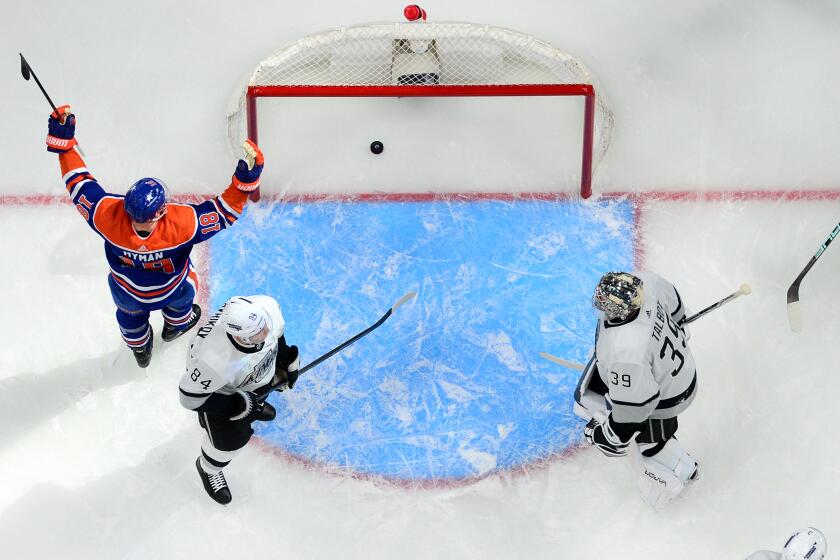The Awful Bears
On the morning after the Monday night game, they were saying in the Windy City that the owners of the Chicago Bears have humiliated them twice.
Cited first is the madeover $365-million stadium. Though comfortable to sit in, new Soldier Field has prompted passersby to call it a space ship on stilts wedged onto old Soldier Field.
Worse are the Bears. The team is a product, Chicago sports fans say, of club owners who don’t understand football, of coaches who don’t understand modern football, and of players who can’t play it.
Green Bay won the modern way, integrating a passer, Brett Favre, with a runner, Ahman Green, on a long series of clever West Coast plays that brought the Bears up to rush Favre when Green had the ball — which was 19 times for 176 yards — and sent them after Green when Favre was firing 21 passes for 179 yards.
In a 38-23 game that the Packers dominated in the first quarter, 17-0, and at the half, 24-6, the old-fashioned home team scored a few meaningless points in the second half when Green Bay’s defensive players had trouble staying awake. But the Bears are 0-3 now and, for the last two years, 4-15, numbers suggesting that neither their owners nor coaches nor most of their players have a clue.
Spurrier, Parcells Bad Luck for Reid
THE FAMOUS NEW COACHES, Steve Spurrier and Bill Parcells, are still winning and still combining their way with mainstream NFL ways. To surprisingly lead the NFC East through the first month of the season, they’ve thrown the ball when they could, they’ve run it when they had to, and played solid defense.
For Spurrier, the Fun-’N’-Gun leader who has revived the Washington Redskins (3-1), it could all blow apart next Sunday at Philadelphia (1-2).
For Parcells, the doctor who mended three other teams before he was called to the Dallas Cowboys (2-1), the string could run to 3-1 against Arizona Sunday before he, too, must settle up in Week 6 with Philadelphia, the great team of the NFC East. The Eagles are still heavily favored in that division.
But as of Week 4, when Dallas, Washington and Philadelphia all won, stormy weather was clearly ahead, this year or next, for Philadelphia’s defending Eastern champions. Indeed, it’s plain bad luck for veteran Eagle Coach Andy Reid that Spurrier chose the NFC East when he came up last year and that Parcells did the same when he came back this year.
McNabb Could Be Taught to Pass
THE EAGLES FOUND a team they could beat Sunday when, in a 23-13 game, their best runner, quarterback Donovan McNabb, outgained the entire Buffalo team. Still, after McNabb’s five years in a well-coached organization, the mystery of Philadelphia is why nobody there can teach him to throw a ball straight.
It isn’t true that human beings are born with or without the ability to run fast or jump high or throw accurately. All physical talents can be improved somewhat.
McNabb in particular is a tremendous athlete with not-bad passing form, meaning that a good teacher should get somewhere with him, but in his many years in the game that’s his life, it hasn’t happened yet.
And so in a tense fourth quarter against Buffalo’s gritty quarterback Drew Bledsoe, it came down to a lucky last run by a swift second-string Eagle, sophomore Brian Westbrook, who in the last 2 minutes slipped through a short-yardage defense and raced past the Bills’ drawn-in secondary to the goal line 62 yards away. Bledsoe deserved better.
Plummer vs. Vermeil Coming Next
JAKE PLUMMER, the new man in Denver (4-0), is already a better quarterback than Kansas City’s veteran 4-0 passer, Trent Green, and that is the Broncos’ edge in the Game of the Year Sunday at Arrowhead Stadium. Setting the table:
Nationwide, football fans, sensing that Kansas City Coach Dick Vermeil is on course to win as usual in his third year in a new town, have been climbing on the Chiefs’ bandwagon.
As luck would have it, this is the season that the Broncos have come on again after a four-year injury-induced layoff since their back-to-back Super Bowl run with Coach Mike Shanahan, who finally has a quarterback again along with most of his indispensable pass receivers plus a bright new one, Ashley Lelie of Hawaii, who is noticeably efficient under a thrown ball.
Because the Chiefs’ running game is so powerful with Priest Holmes, the question of the week is whether Bronco running back Clinton Portis will be there and if so how long he lasts.
With an injury diagnosed as a bruised chest, Portis missed Week 4 but needs to return in Week 5 to keep the Kansas City defense off Plummer. Carrying the ball when well, that Portis can do. A more electrifying ballcarrier than Holmes or any other active back, Portis, listed at 205 pounds, is too small for modern football. Hence durability is his problem. His replacement, the 1,000-yard tailback/fullback Mike Anderson, is no Portis.
Officials Get It Right Again
WHEN KANSAS CITY and Denver both won in Week 4 — the Chiefs at Baltimore, 17-10, and the Broncos over Detroit, 20-16 — both were clearly saving themselves for their Week 5 headliner. It says something for both that, looking ahead, they could even beat on-the-rise teams.
The Chiefs couldn’t have done it without Baltimore’s decision to use a rookie quarterback this year, Kyle Boller, in place of the veteran that Coach Brian Billick could have found, no doubt, but at a cost of much of his time and much of the owner’s money.
As for the Broncos, they played two games, in effect, against Detroit, a first half in which Plummer threw his two touchdowns while completing 16 in a row and a second half which they took off.
The Denver-Detroit game will be remembered, if it is remembered at all, as the one that proved to a skeptical football audience that the ground can cause a fumble. When it caused Plummer to lose the handle at the end of a scramble for a first down, no opponent laid a hand on him.
Though few fans completely understood what was going on, the officials instantly enforced a peculiar, obscure rule that a fumbling ballcarrier, when landing on the ground, must have some kind of contact with an opposing player in order to retain possession.
It was another example of the truism that NFL game officials are usually right. They take a lot of heat for perceived mistakes, mainly from sports fans supporting losers — but considering the difficulty of officiating a fast-moving event contested by so many participants, they’re the most effective of all sports officials.
The Powerful Raider Kicker
THE DEFENDING AFC and AFC West champion Raiders are off to a 2-2 start — leaving them two games behind Denver and Kansas City — in part because their pass offense isn’t quite as slick as it was a year ago and also because their ballcarriers aren’t as productive. Certainly against San Diego Sunday, they weren’t.
All this forces passer Rich Gannon to take the Raiders the length of the field with short stuff just to get even after any opponent scores, and he can’t always do that.
On the other hand, the Oakland people could outpoint the luckless Chargers in overtime, 34-31, because they have a strong-legged kicker, Sebastian Janikowski, whose lower appendages are so very strong that he could kick the winning field goal 46 yards — off the bare Oakland infield — with leg power alone, without getting the body power other kickers need.
Hemmed in on bare ground, Janikowski couldn’t take a chance with a leap that would have enabled him to plant his cleats firmly in the turf before swinging his leg, which would have taken him sliding along the ground into a flub. Knowhow plus talent make him the game’s best kicker.
Moreover, Janikowski, who also fits the Raider-playboy stereotype, remains one of Oakland owner Al Davis’ best first-round draft choices though both men were loudly criticized that year (2000) in some NFL towns where, since then, people have missed a lot of big field goals. To be sure, Janikowski has missed one or two as well, but not lately. Not Sunday.
Mike Tice: Early-On Coach of Year
THE MINNESOTA VIKINGS, 4-0 as they head for Atlanta (1-3) Sunday, are the NFC’s most effective team after concluding the first of pro football’s four regular-season months with a smashing 35-7 victory over the confused San Francisco 49ers.
Asked to play without injured quarterback Daunte Culpepper, the Vikings got four touchdown passes from backup Gus Frerotte to make Coach Mike Tice look like a wonderman.
Actually, Tice is the least qualified of the NFL’s 32 coaches. He is, that is, if you count coaching experience. When Minnesota hired him on Jan. 10, 2002, Tice could look back on only six seasons as a coach — all as an assistant, all with the Vikings — after ending a 14-year playing career as an NFL tight end with three Viking seasons.
Even considering that he’s a former Maryland quarterback who therefore knows something about both ends of pass offense, he was a strange choice for a head coach unless you’re watching pennies, as owner Red McCombs was and obviously still is.
Yet you never know about any new head coach. Any new one could give you anything from some championship days to a lot of cellar time. And Tice is winning now at least because, among other matters, he’s riding a dominating NFL trend — the use of monster linemen. He learned the importance of huge blockers as a line coach for five years at Minnesota.
The Raiders and others are also on the big-line kick, but Tice is taking it to a new high with five linemen who all top 300 pounds and average 326, and who, accordingly, nicely protected Frerotte from the 49er rush. At Denver on Oct. 19, Tice will get another kind of test. The Broncos win with the smallest of offensive linemen.
Big Blockers Make It Easier for Frerotte
NO MINNESOTA VIKING expects Tice to have a quarterback controversy when Culpepper returns. Nonetheless, judging by the Minnesota-San Francisco game, the Vikes are better conditioned for backup-quarterback help than most NFC Northern opponents, including Green Bay, if Frerotte is that good. Is he?
The best answer is, who knows? During his 10 NFL seasons, Frerotte has played for 5 teams — Washington, Detroit, Denver, Cincinnati and Minnesota — usually as a backup. He has often appeared to be just good enough to be a backup. His personal history reveals that when upgraded from backup to starter for whatever reason, he doesn’t make it.
Yet Frerotte is a graceful player and fluid passer who completed all but five of 21 throws to whop San Francisco. It happened in large part because Tice’s large offensive line helped him unreservedly. There were in truth many times when, as Frerotte retreated to read San Francisco’s defenses, a distance of 5 or 10 yards or more separated him from the nearest 49er rushman.
This may have demonstrated that Frerotte, to be efficient, needs just what Tice gave him, breathing room manufactured by those 326-pound blockers. When heavily rushed in other years, Frerotte has had his troubles. Not that he’s the only passer in the world who needs time. But at Minnesota at least, his new coach may be onto something.
One Best Football Game Plan
THE TICE OPERATION at Minnesota is worth any other NFL coach’s scrutiny. It isn’t as strange as the ascent of the headman himself but it’s different from most in this fussy, copycat league.
For example, as Tice’s first major hire, he brought in George O’Leary — the controversial college coach from Georgia Tech — as his defensive coordinator after studying O’Leary’s contributions to the San Diego Chargers for a couple of years. The 49ers could accomplish naught against O’Leary’s defensive designs.
As his pass-defense coach, Tice kept Chuck Knox Jr., who made an impression on Tice after joining the Vikings in 2000. In the beginning, Knox had coached for his father on the old Los Angeles Rams before diversifying at Green Bay and Philadelphia.
Strangest and most significant of all, Tice picked up, as his most important assistant, an offensive coordinator who had never played or coached pro ball, and who indeed had coached at only one big-time university: Scott Linehan of Sunnyside, Wash.
For the 49ers, Linehan put in a simple game plan — the simplest and probably best plan of them all — one requiring Frerotte to throw the ball whenever the 49ers displayed a run-based design and to hand off for running plays when the 49ers lined up in a pass defense.
If that’s as simple as it sounds, it’s so hard to accomplish, play after play after play, that few if any NFL signal-callers can stay with it. The temptation to vary one’s game-day approach is plainly so powerful that great play-callers such as Ram Coach Mike Martz often stray, and therefore often lose by, for instance, sending their running backs into 8-3 run defenses.
On the occasions in Week 4 when the 49ers presented an eight-man front, Frerotte, following Linehan’s instructions, passed every time, even when his most celebrated receiver, Randy Moss, was closely covered. The Vikings were confident that Moss could beat any single-covering defensive back every time. But not double coverage.
So when the 49ers shifted into pass defenses, Frerotte regularly handed off to his running backs and gained some key yardage even though injuries have left Minnesota with very ordinary ballcarriers by comparison with San Francisco’s superb pair, Garrison Hearst and Kevan Barlow.
To stay with superlatives, San Francisco’s best pass receiver, Terrell Owens, is better than Moss — which contradicts what Owens said Sunday. But a difference Sunday was that San Francisco didn’t attack opposing defenses with Linehan’s game plan. Nor with Tice’s mighty offensive line. The Vikings may in time fade away to mediocrity, but they’re unbeaten now and, for one game, they were overpowering. They dominated the team that not long ago was much better than they are.
Bob Oates’ book, Sixty Years of Winners, is available at latimes.com/bookstore or by calling (800) 246-4042 ($16.95).
More to Read
Get our high school sports newsletter
Prep Rally is devoted to the SoCal high school sports experience, bringing you scores, stories and a behind-the-scenes look at what makes prep sports so popular.
You may occasionally receive promotional content from the Los Angeles Times.






